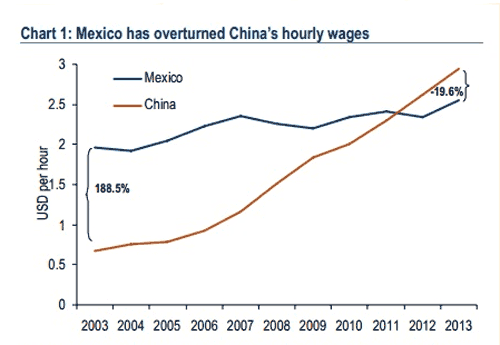From SCDigest's On-Target e-Magazine
- April 8, 2013 -
Supply Chain News: Rise in China Wages Now Means Labor Costs about 20% Lower in Mexico, New Study Finds
Wages have Stagnated in Mexico for a Decade, While Rising Sharply in China, New Bank of America Study Says, as Country Becomes Increasingly Favored Sourcing Point
SCDigest Editorial Staff
It's not only the US that has recently seen its manufacturing sector benefitted from rising wages and labor costs in China. A new report from the analysts at Bank of America says that Mexico is also a winner from that change, leading to a dramatic turnaround in comparative wage rates.
SCDigest Says: |
 |
What Mexico produces is no longer overwhelmingly headed to the US. Ten years ago, some 90% of Mexico's exports went to the US. In 2011, it was less than 80%.
|
|
What Do You Say?
|
|
|
|
Just 10 years ago, Mexican labor rates versus the US dollar were 188% higher than those in China, according to the new report from the bank's chief Mexican economist Carlos Capistran. Now, as shown in the chart below, that situation has changed dramatically, with Mexican labor now about 20% less expensive than China.
What is going on here? It is simple supply and demand, at one level. China's population is aging, and draconian "one child" policies mean the availability of younger workers is stagnant. Combine that with huge growth in demand for labor in Chinese manufacturing, and state policies designed to push wages up (e.g., several increases in recent years of the minimum wage) and the result is predictable - average wage rates in the coastal areas at least have risen substantially in recent years.
It's the other way in Mexico, which has seen a rising population and a high percentage of young workers. Until the last few years, manufacturing need for workers was dampened as China took share away from Mexico in industries such as apparel and shoes after China entered the World Trade Organization in 2001.
The result: it's the wages that have stagnated in Mexico, not the supply of workers, now giving it a labor cost advantage versus China on top of its advantages in terms of proximity, speed of delivery , and operating at the same time of day as the US.
As shown in another chart below, although the US imported about $150 billion more goods from China than from Mexico in 2012, Mexican imports are growing at a faster rate. Since 2010, Mexican imports are up 32%, while those from China are up just over 20%.

Source: Bank of America
It's also worth noting that the US exports far more to Mexico than to China, such that the trade deficit in goods with Mexico is just $61.4 billion, while the trade deficit with China last year was a massive $325 billion.
All told, China accounted for 17.5% of US imports last year, while Mexico had a 12.4% share.
As a result of all this, there has been a lot of foreign investment in Mexico in recent years by the US and other countries. The US auto industry has been in Mexico for years. Now, despite worries about drug gangs and violence, others are also making the move.
(Global Supply Chain Article Continued Below)
|